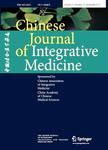Structural Basis for Complementary and Alternative Medicine:Phytochemical Interaction with Non-Structural Protein 2 Protease-A Reverse Engineering Strategy
Structural Basis for Complementary and Alternative Medicine:Phytochemical Interaction with Non-Structural Protein 2 Protease-A Reverse Engineering Strategy作者机构:Molecular Biophysics LaboratorySchool of Chemical and BiotechnologyShanmuga Arts Science Technology Research Academy University Assistant Medical OfficerGoverment Hospital
出 版 物:《Chinese Journal of Integrative Medicine》 (中国结合医学杂志(英文版))
年 卷 期:2015年第21卷第6期
页 面:445-452页
核心收录:
学科分类:1008[医学-中药学(可授医学、理学学位)] 1006[医学-中西医结合] 100602[医学-中西医结合临床] 10[医学]
基 金:Supported by Shanmuga Arts Science Technology Research Academy University Fund(Feb 2012 Scheme) Junior Research Fellowship from Department of Science and Technology,Government of India
主 题:chikungunya virus non-structural protein 2 protease Grid Based Ligand Docking with Energetics score Nilavembu Kudineer Swasthya Raksha Amruta Peya
摘 要:Objective: To understand the druggability of the bioactive compounds from traditional herbal formulations "Nilavembu Kudineer" and "Swasthya Raksha Amruta Peya" to heal chikungunya virus (CHIKV) infection. Methods: The efficiency of twenty novel chemical entities from "Nilavembu Kudineer" and "Swasthya Raksha Amruta Peya" to inhibit CHIKV infection in silico were evaluated. Ligands were prepared using Ligprep module of Schr0dinger. Active site was identified using SiteMap program. Grid box was generated using receptor grid generation wizard. Molecular docking was carried out using Grid Based Ligand Docking with Energetics (GLIDE) program. Results: Molecular docking studies showed that among twenty compounds, andrographoside, deoxyandrographoside, neoandrographolide, 14-deoxy-11-oxoandrographolide, butoxone and oleanolic acid showed GLIDE extra precision (XP) score of-9.10,-8.72, -8.25,-7.38,-7.28 and -7.01, respectively which were greater than or comparable with chloroquine (reference compound) XP score (-7.08) and were found to interact with the key residues GLLI 1043, LYS 1045, GLY 1176, LEU 1203, HIS 1222 and LYS 1239 which were characteristic functional unit crucial for replication of CHIKV. Conclusion: The binding affinity and the binding mode of chemical entities taken from herbal formulations with non-structural protein 2 protease were understood and our study provided a novel strategy in the development and design of drugs for CHIKV infection.



